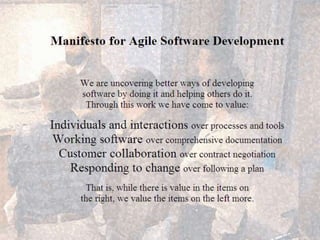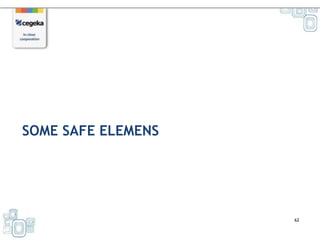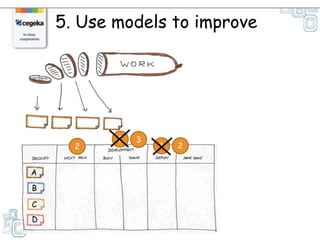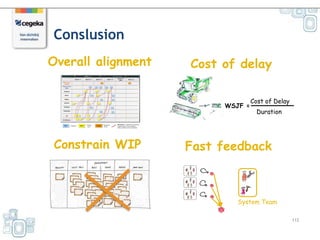Agile at enterprice level
- 1. Agile at the enterprise level 01/10/2014
- 2. Jan De Baere 20+ years in IT 10+ years into Agile 5+ years Agile @ scale Chair Agile Consortium Belgium Jan.debaere@cegeka.be
- 3. INTRO 3
- 4. In the good old days Project: Build 1 long lasting stable (stand alone) application
- 5. In the good old days
- 6. Projects in the old days: Build 1 long lasting stable application Projects today: Create/update a complex dynamic service ? IT centric Business/user centric
- 7. 2001 Snowbird Agile Manifesto
- 10. When is Agile useful? Solution/technology Requirements
- 11. 11 Process PostIT’s… Values Principles Attitude
- 12. SCALING 12
- 14. Scrum
- 15. Testing
- 16. Requirements
- 17. DevOps
- 18. Scaling
- 19. SAFE 19
- 26. Scaled Agile Framework e
- 27. SAFe is a template, for a large scale software development organisation, that exhibits agility.
- 28. SAFe Overview Team Program Portfolio
- 29. SAFe Overview Team Program Portfolio
- 37. Scrum master
- 38. Product owner Scrum master
- 39. SAFe Overview Team Program Portfolio
- 45. Product manager
- 46. Product manager
- 47. Product manager
- 48. Product manager Release train engineer
- 49. Product manager Release train engineer Product manager
- 50. SAFe Overview Team Program Portfolio
- 57. Enterprise architect Epic owner
- 58. EA EO
- 59. EA EO
- 60. EA EO
- 61. SAFe Overview Team Program Portfolio
- 62. SOME SAFE ELEMENS 62
- 64. There is more value created with overall alignment than with local excellence. >> Don. Reinertsen, The Principles of Product Development Flow <<
- 65. Epic layer Feature layer Story layer
- 67. • Context • Roadmap • Architecture ITC PM FO EA IT Integrator
- 71. 71
- 72. 72
- 73. 73
- 74. Fast feedback optimizes payoff. Tackle highest risk first
- 76. System Demo
- 77. System Demo
- 78. System Team
- 79. Constrain WIP to control cycle time and flow. >> Don. Reinertsen, The Principles of Product Development Flow <<
- 80. Constrain WIP to control cycle time and flow. >> Don. Reinertsen, The Principles of Product Development Flow << WIP = Work In Progress
- 82. Epic Kanban
- 83. Kanban properties 1. Visualize workflow 2. Limit work-in-progress 3. Measure and manage flow 4. Make process policies explicit 5. Use models to recognize improvement opportunities
- 86. E F G H A B C D 1. Visualize workflow
- 87. E F G H A B C D 1. Visualize workflow
- 88. 2. Limit work-in-progress E F G H A B C D 2 2 1
- 90. 2. Limit work-in-progress E F I G H D C B A 2 2 1 J M K L
- 91. 2. Limit work-in-progress E F I G H C B A D 2 2 1 J M K L
- 92. 3. Measure and manage flow A C D A B
- 93. 4. Make process policies explicit A B C D
- 94. 4. Make process policies explicit B C D A A
- 95. 5. Use models to improve 2 2 1 A B C D 3 2
- 96. Kanban A B C D 2 2 1
- 97. Weighted Shortest Job First
- 98. If you only quantify one thing, quantify the cost of delay. >> Don. Reinertsen, The Principles of Product Development Flow <<
- 99. Epic layer Feature layer Story layer
- 100. Job Sequencing
- 101. ROI = Value Cost
- 102. ROI = Value Cost
- 106. Equal Cost of Delay A: $$, 1 day B: $$, 3 days C: $$, 10 days
- 107. Equal Duration A: $$$, 3 days B: $$, 3 days C: $, 3 days
- 109. WSJF = Cost of Delay Duration ROI = Value Cost
- 110. WSJF = Cost of Delay Duration User/Business Value + Time Criticality + RR/OE Value Job Size = ROI = Value Cost
- 112. 112 Conslusion Overall alignment Cost of delay WSJF = Cost of Delay Duration Constrain WIP Fast feedback System Team
- 113. ADENDUM
- 114. The case against scaling From EGO to ECO
- 115. Visibility
- 116. Visibility
- 117. Visibility
- 118. Silo’s Collaboration
Editor's Notes
- Before you could say read the fucking manual. If today you still need manual you’re out of business It’s about another level of service IT has to provide. Business knows the price & speed at which you can rent storage at amazon and they demand the same level of service. App market? There is abundance of software. They aim is not longer to make software, nor to sell software just to get your free app used by a customer… Differentiator? added value for the user. Remark that added value is not only functionality but can be – and is more and more - design as well.
- Promise of agile: More business value faster
- The difficulty of Agile is in values, principles and Attitude.
- Close the part with putting in production. Collaboration is not enough. Tools is nessesary e.g. testautomation, deployment…
- From agile team/project to agile company/IT Less: Large scale scrum Dad: Disciplined agile delivery SAFe: Scaled agile framework In common Combine Lean & Agile Basic component: scrum team recurcivity
- Goal: decisions are taken at the right level: Priority of epics is decided at portfolio/epic level: not to be discussed further on – as a guidance for the other levels Priority of features in PSI: decided on program/feature level … Combine Agile & lean
- Presence: everybody of the release train (organize yourselves!) Organizer: ING IT Integrator or IT Integrator Start with context (PPM), Roadmap en Architectore ING termen: Investment them committee, program manager, feature owner en it integrator ipv Program Portfolio management, Epic owner, Program manager and release train engineer
- EO, EA, RTE and PPM are present for questions SoS each hour (SM, PO an program level)
- Outcome for a team: PSI objectives (PO gives bus. Value (with PPM and Product Manager (CPO)) Risks and impediments per team
- Features: so when a feature as a whole is delivered Yellow: dependent feature input that need to be finished (by other teams) in order to deliver the features Place of the post-its does not say anything of when a team starts with a feature or feature input. Line: features with input: features to be developed by different teams, with dependencies (for each team)
- Slice the work in small pieces. Make a card for each of these pieces.
- Draw columns for each of the process steps.
- Stick the cards in the columns.
- And pull the work items through the process steps. It’s visual, simple and improves shared understanding.
- Put a limit on the number of work items that can live in a column. This limit is called the W.I.P. limit, Work-In-Progress limit.
- Prevent overload. Avoid to start many but to finish few. Avoid task switching. Increase focus.
- Decrease lead time. Enable fast feedback.
- Identify bottlenecks. And hence improve flow.
- Measure lead time.
- Class of service
- Definition of done
- Job sequencing algorithm If you only quantify one thing, quantify the cost of delay
- How do you prioritize epic and feature backlogs?
- Cost of delay Duration => job size Ratio of business value over effort size Business value => value to user or business; time criticality to user or business; … => opportunity cost to delay implementation => cost of delay Effort size => duration
- Cost of delay Duration => job size Ratio of business value over effort size Business value => value to user or business; time criticality to user or business; … => opportunity cost to delay implementation => cost of delay Effort size => duration
- Example: fashion
- Example: process automation
- Cost of delay Duration => job size Ratio of business value over effort size Business value => value to user or business; time criticality to user or business; … => opportunity cost to delay implementation => cost of delay Effort size => duration
- Cost of delay Duration => job size Ratio of business value over effort size Business value => value to user or business; time criticality to user or business; … => opportunity cost to delay implementation => cost of delay Effort size => duration
- Controversy around scaling in agile community: Culture for value creation and speed?: free market. They produce more and faster then people can follow. Companies adore it and ask less government, less rules, less administration in order to speed up. Basically: get out of the way of companies who want to work, that is how added value is created. By contract there is no added value create : how the western world sees communism with their central and planned economy wand lots of control. They needed to build a wall to keep people inside. Strange: external, organizations want free market, internal organization of companies is more like... Feedback from people in bigger companies: less governance, less rules, less administration get out of the way of people who want to work that is how added value is created. Fundamental remark from agile community: you can turn a blue triangle into a green one but it remains a triangle. Agile is going to another type of organisation like adhocraty, network organisation, innovative ecosystems… My conclusion: there will be a case against scaling in 5-10 years time for the bigger companies. You can’t go from a blue triangle to a green circle directly (evolution not revolution.) From talking about agile (triangle) to being agile e.g. Spotiy: by the time the structure is described it has changed. (tip as long as you have reorganisations you have planned change
- All Disiplines are done one after another Business involvement is high in the beginning and the end of te project






















































































































